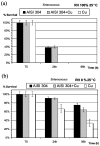Antibacterial Metallic Touch Surfaces
- PMID: 28773856
- PMCID: PMC5457048
- DOI: 10.3390/ma9090736
Antibacterial Metallic Touch Surfaces
Abstract
Our aim is to present a comprehensive review of the development of modern antibacterial metallic materials as touch surfaces in healthcare settings. Initially we compare Japanese, European and US standards for the assessment of antimicrobial activity. The variations in methodologies defined in these standards are highlighted. Our review will also cover the most relevant factors that define the antimicrobial performance of metals, namely, the effect of humidity, material geometry, chemistry, physical properties and oxidation of the material. The state of the art in contact-killing materials will be described. Finally, the effect of cleaning products, including disinfectants, on the antimicrobial performance, either by direct contact or by altering the touch surface chemistry on which the microbes attach, will be discussed. We offer our outlook, identifying research areas that require further development and an overview of potential future directions of this exciting field.
Keywords: antimicrobial; copper; disinfection; touch surfaces.
Conflict of interest statement
The authors declare no conflict of interest.
Figures






Similar articles
-
Self-Disinfecting Copper Beds Sustain Terminal Cleaning and Disinfection Effects throughout Patient Care.Appl Environ Microbiol. 2019 Dec 13;86(1):e01886-19. doi: 10.1128/AEM.01886-19. Print 2019 Dec 13. Appl Environ Microbiol. 2019. PMID: 31704675 Free PMC article.
-
Metallic copper as an antimicrobial surface.Appl Environ Microbiol. 2011 Mar;77(5):1541-7. doi: 10.1128/AEM.02766-10. Epub 2010 Dec 30. Appl Environ Microbiol. 2011. PMID: 21193661 Free PMC article. Review.
-
Surface-attached cells, biofilms and biocide susceptibility: implications for hospital cleaning and disinfection.J Hosp Infect. 2015 Jan;89(1):16-27. doi: 10.1016/j.jhin.2014.09.008. Epub 2014 Oct 2. J Hosp Infect. 2015. PMID: 25447198 Review.
-
Modern technologies for improving cleaning and disinfection of environmental surfaces in hospitals.Antimicrob Resist Infect Control. 2016 Apr 11;5:10. doi: 10.1186/s13756-016-0111-x. eCollection 2016. Antimicrob Resist Infect Control. 2016. PMID: 27069623 Free PMC article. Review.
-
Copper as an antibacterial material in different facilities.Lett Appl Microbiol. 2017 Jan;64(1):19-26. doi: 10.1111/lam.12680. Epub 2016 Nov 28. Lett Appl Microbiol. 2017. PMID: 27718259
Cited by
-
Back to Basics: Choosing the Appropriate Surface Disinfectant.Antibiotics (Basel). 2021 May 21;10(6):613. doi: 10.3390/antibiotics10060613. Antibiotics (Basel). 2021. PMID: 34063833 Free PMC article. Review.
-
Rapid antibacterial activity of anodized aluminum-based materials impregnated with quaternary ammonium compounds for high-touch surfaces to limit transmission of pathogenic bacteria.RSC Adv. 2021 Nov 26;11(60):38172-38188. doi: 10.1039/d1ra07159a. eCollection 2021 Nov 23. RSC Adv. 2021. PMID: 35498065 Free PMC article.
-
Enhancing Biocidal Capability in Cuprite Coatings.ACS Biomater Sci Eng. 2023 Jul 10;9(7):4178-4186. doi: 10.1021/acsbiomaterials.2c01222. Epub 2023 Jun 2. ACS Biomater Sci Eng. 2023. PMID: 37267510 Free PMC article.
-
Does Extreme Wettability Matter: The Effect of Copper Wettability on Infection Spread through Hospital Surfaces.ACS Omega. 2025 May 5;10(18):19129-19138. doi: 10.1021/acsomega.5c01931. eCollection 2025 May 13. ACS Omega. 2025. PMID: 40385144 Free PMC article.
-
Assessing Antimicrobial Efficacy on Plastics and Other Non-Porous Surfaces: A Closer Look at Studies Using the ISO 22196:2011 Standard.Biology (Basel). 2024 Jan 20;13(1):59. doi: 10.3390/biology13010059. Biology (Basel). 2024. PMID: 38275735 Free PMC article. Review.
References
-
- European Centre for Disease Prevention and Control . Point Prevalence Survey of Healthcare Associated Infections and Antimicrobial Use in European Acute Care Hospitals. ECDC; Stockholm, Sweden: 2013.
-
- European Centre for Disease Prevention and Control . Antimicrobial Resistance Surveillance in Europe 2014. Annual Report of the European Antimicrobial Resistance Surveillance Network (EARS-Net) ECDC; Stockholm, Sweden: 2015.
-
- Dollwet H.H.A., Sorenson J.R.J. Historic Uses of Copper-Compounds in Medicine. Trace Elem. Med. 1985;2:80–87.
Publication types
LinkOut - more resources
Full Text Sources
Other Literature Sources

